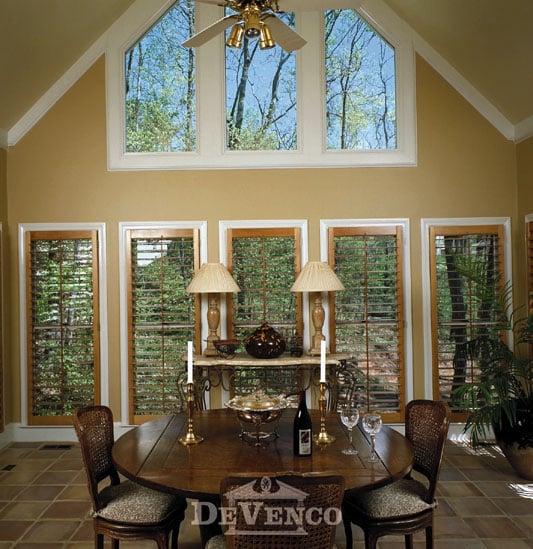



We have studied the history and design of wooden shutters with an eye toward reproducing this original product. Americana DeVenco Shutters offers high quality, custom manufactured wooden shutters, authentically reproduced and handcrafted to the highest standards. Our products allow you to maintain the authenticity of your historic home and provide a fresh, clean look to more contemporary properties.
Using modern tools, our skilled craftsmen fabricate shutters to your exact requirements. We prepare computer-aided-design drawings for our shutters so that customers can confirm the measurements. This allow us to produce high quality wood shutters that meet each project requirements. We are able to offer many choices in styles and types of shutters as well as being able to match any brand and color of paint or stain. Because we fabricate everything to your exact measurements, special sizes are not an issue for us. Whether you are looking for an historically accurate shutter or something more contemporary, we have a product to fit your needs.

We can walk you through measuring, pricing, color matching and ordering of your new shutters. We can even offer assistance by phone with installation. Our knowledge of windows is considerable. Our 70 years of customer service is here for you.
| Cookie | Duration | Description |
|---|---|---|
| cookielawinfo-checkbox-advertisement | 1 year | Set by the GDPR Cookie Consent plugin, this cookie is used to record the user consent for the cookies in the "Advertisement" category . |
| cookielawinfo-checkbox-analytics | 11 months | This cookie is set by GDPR Cookie Consent plugin. The cookie is used to store the user consent for the cookies in the category "Analytics". |
| cookielawinfo-checkbox-functional | 11 months | The cookie is set by GDPR cookie consent to record the user consent for the cookies in the category "Functional". |
| cookielawinfo-checkbox-necessary | 11 months | This cookie is set by GDPR Cookie Consent plugin. The cookies is used to store the user consent for the cookies in the category "Necessary". |
| cookielawinfo-checkbox-others | 11 months | This cookie is set by GDPR Cookie Consent plugin. The cookie is used to store the user consent for the cookies in the category "Other. |
| cookielawinfo-checkbox-performance | 11 months | This cookie is set by GDPR Cookie Consent plugin. The cookie is used to store the user consent for the cookies in the category "Performance". |
| elementor | never | This cookie is used by the website's WordPress theme. It allows the website owner to implement or change the website's content in real-time. |
| viewed_cookie_policy | 11 months | The cookie is set by the GDPR Cookie Consent plugin and is used to store whether or not user has consented to the use of cookies. It does not store any personal data. |
| Cookie | Duration | Description |
|---|---|---|
| _ga | 2 years | The _ga cookie, installed by Google Analytics, calculates visitor, session and campaign data and also keeps track of site usage for the site's analytics report. The cookie stores information anonymously and assigns a randomly generated number to recognize unique visitors. |
| _ga_9VR1X4YEN6 | 2 years | This cookie is installed by Google Analytics. |
| _hjAbsoluteSessionInProgress | 30 minutes | Hotjar sets this cookie to detect the first pageview session of a user. This is a True/False flag set by the cookie. |
| _hjFirstSeen | 30 minutes | Hotjar sets this cookie to identify a new user’s first session. It stores a true/false value, indicating whether it was the first time Hotjar saw this user. |
| _hjIncludedInPageviewSample | 2 minutes | Hotjar sets this cookie to know whether a user is included in the data sampling defined by the site's pageview limit. |
| _hjIncludedInSessionSample | 2 minutes | Hotjar sets this cookie to know whether a user is included in the data sampling defined by the site's daily session limit. |
| Cookie | Duration | Description |
|---|---|---|
| NID | 6 months | NID cookie, set by Google, is used for advertising purposes; to limit the number of times the user sees an ad, to mute unwanted ads, and to measure the effectiveness of ads. |
| Cookie | Duration | Description |
|---|---|---|
| _hjSession_2727062 | 30 minutes | No description |
| _hjSessionUser_2727062 | 1 year | No description |